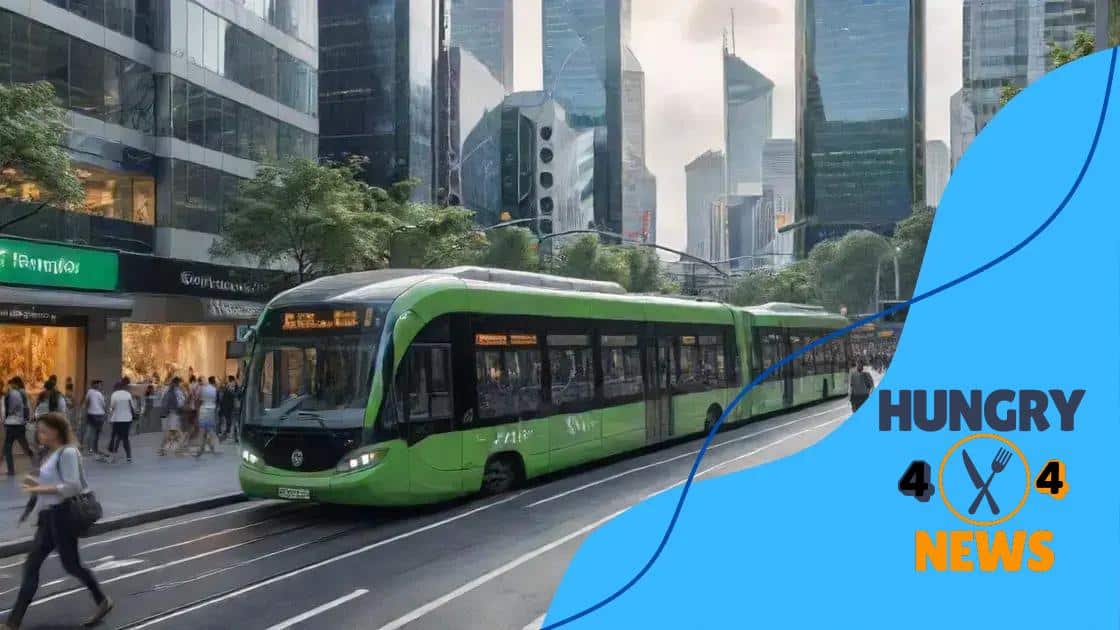Smart cities using data to enhance quality of life

Smart cities utilize advanced technologies such as data analytics and IoT to enhance urban living, streamline services, and engage communities in creating efficient, sustainable environments.
Smart cities using data to improve quality of life are reshaping our urban landscapes. Have you ever thought about how technology can make your city more livable? From better traffic management to enhanced public services, let’s dive into how data is changing the way we experience city life.
Understanding smart cities and their importance
Understanding smart cities is essential for grasping how technology can enhance urban living. These cities leverage data and technology to improve various aspects of daily life, making them not only more efficient but also more sustainable.
By integrating systems such as traffic management, public safety, and energy consumption, smart cities create an interconnected urban ecosystem. This network allows for a quicker response to issues and a better quality of life for residents.
Key Features of Smart Cities
Smart cities revolve around several key features that contribute to their efficiency:
- Data-driven decision making: Utilizing real-time data helps city officials make informed decisions.
- IoT technology: Smart devices and sensors constantly gather data to optimize various city functions.
- Integrated public services: Services like transportation and utilities work seamlessly together.
Moreover, it’s vital to understand that the community plays a pivotal role in the success of a smart city. Resident engagement encourages greater adaptability and responsiveness to public needs.
Access to real-time information lets citizens participate in decision-making processes. Whether it’s through traffic apps or public forums, technology encourages a collaborative spirit.
Why Are Smart Cities Important?
Smart cities are significant for many reasons. First, they enhance the livability of urban areas by streamlining services and reducing response times to emergencies. Environmental sustainability is another crucial aspect, as smart solutions often lead to lower energy consumption and reduced waste.
Implementing these technologies can also have economic benefits. They draw investments and can create job opportunities in various sectors, from tech start-ups to public transportation.
Finally, smart cities foster resilience against challenges like climate change and urbanization. By using data effectively, cities can adapt and evolve, ensuring a better future for all residents.
How data analytics transforms urban living
How data analytics transforms urban living is a crucial topic in the discussion of smart cities. By harnessing the power of data, cities can make informed decisions that significantly enhance daily life for their residents.
Data analytics helps cities understand patterns in various aspects of urban living, such as traffic flow, energy consumption, and public safety. This information enables city planners to optimize services and improve infrastructure effectively.
Benefits of Data Analytics in Cities
There are several notable benefits that data analytics brings to urban environments:
- Enhanced traffic management: Data from sensors and cameras allows cities to adjust traffic lights and routes to reduce congestion.
- Improved public safety: Analysis of crime data can help allocate police resources more effectively.
- Energy efficiency: Smart grids use data to manage energy distribution, reducing waste and lowering costs.
These benefits demonstrate the tangible impact of data on everyday city life. The use of data analytics can lead to smarter resource management and a better quality of living.
Moreover, integrating data into urban planning fosters a more responsive governance model. City officials can anticipate needs based on historical data trends. For instance, if a neighborhood frequently reports high energy use, targeted solutions can be deployed to address the issue.
Moreover, engaging residents through data initiatives enhances community involvement. Citizens can contribute to platforms that track data, offering insights that help shape local policies. This fosters a sense of collaboration between officials and the community.
Challenges in Implementing Data Analytics
Despite its advantages, several challenges arise when implementing data analytics in urban settings. Privacy concerns are a top issue, as residents may worry about how their data is being used. Additionally, ensuring data quality and integrating various data sources can be technically demanding.
Overcoming these challenges requires a transparent approach from city officials. By communicating openly about data usage and protection measures, trust can be built within communities, paving the way for successful data-driven initiatives.
Key technologies driving smart cities

Key technologies driving smart cities play a pivotal role in enhancing the urban experience for residents. As cities evolve, integrating modern technologies becomes essential for effective management and improved quality of life.
Among these technologies, the Internet of Things (IoT) stands out. IoT connects devices within the urban environment, enabling them to communicate and share data. This connectivity optimizes resource usage and enhances service delivery.
Essential Technologies in Smart Cities
Several core technologies are fundamentally shaping the development of smart cities:
- Smart sensors: These are deployed throughout urban areas to monitor and collect data on factors like air quality, traffic patterns, and energy consumption.
- Big Data Analytics: Analysis of large sets of data helps city planners make informed decisions based on patterns and trends observed in the collected information.
- Cloud Computing: Cloud technology allows for better data storage and sharing, making it easier to manage and access information remotely.
As these technologies intertwine, they facilitate more efficient city operations. For example, traffic sensors can inform adaptive signal control systems, reducing congestion in real-time. This interconnectedness not only benefits commuters but also decreases emissions, contributing to a cleaner environment.
Another significant technology is artificial intelligence (AI). AI algorithms process data from various sources to predict issues and recommend actions. For instance, AI can analyze patterns in public transport usage, helping to adjust schedules and routes for optimal efficiency. This use of technology is vital for enhancing the overall experience within cities.
Impact of Communication Technologies
Communication technologies also play a crucial role in smart cities. 5G networks, for instance, provide the high-speed connectivity necessary for various applications, from autonomous vehicles to remote health monitoring solutions.
The implementation of these advanced technologies brings various benefits. Improved connectivity enables more flexible city services and facilitates resident interactions with city departments. Moreover, as integration increases, it allows cities to become more resilient in the face of challenges like climate change, overcrowding, and resource scarcity.
Real-world examples of smart city initiatives
Real-world examples of smart city initiatives illustrate how cities around the globe are successfully integrating technology to improve urban life. These initiatives showcase innovative solutions that address various urban challenges.
One prominent example is Singapore. The city-state has implemented a range of smart technologies to enhance public services. Through its Smart Nation initiative, Singapore utilizes data analytics to monitor traffic conditions and reduce congestion. Sensors are placed on roads and public transport systems to gather real-time data, which helps manage traffic flow effectively.
Other Notable Smart Cities
Barcelona is another excellent case of smart city implementation. The city uses IOT devices to manage its waste collection system. Smart bins equipped with sensors signal when they are full, optimizing collection routes and reducing costs. This not only improves efficiency but also promotes sustainability.
- Chicago: The city has developed a data-driven approach to urban planning, using analytics to improve infrastructure and city services.
- Amsterdam: This city focuses on smart energy management, implementing smart grids that allow for better energy distribution and usage.
- Dubai: Dubai’s ‘Smart Dubai’ initiative aims to make the city the happiest on earth through technology by enhancing services like transportation and public safety.
Furthermore, outside of these global examples, smaller cities are also adopting smart initiatives. Cities like Madison in the USA are using data to enhance public safety and citizen engagement. Their smart city projects focus on integrating community feedback into decision-making processes.
These efforts demonstrate the tangible benefits that come from investing in smart city technologies. From reduced traffic congestion to improved waste management, the positive impact of these initiatives is clear. Cities are becoming more efficient, sustainable, and responsive to the needs of their residents, paving the way for future innovations.
Future trends in smart cities and urban planning
Future trends in smart cities and urban planning are shaping how we envision our urban environments. As technology advances, cities are likely to become even more connected and responsive to their residents’ needs.
One key trend is the increasing adoption of artificial intelligence in urban planning. AI can analyze vast amounts of data to predict city needs and optimize resource allocation. For instance, AI can help forecast traffic patterns or identify areas that need more public services.
Emerging Technologies
Another significant trend is the rise of sustainable practices in urban development. Cities are focusing on building greener infrastructures to reduce their carbon footprints. This includes developing renewable energy sources like solar and wind power to lessen dependency on fossil fuels.
- Smart grids: These energy systems increase efficiency by allowing cities to manage energy usage better.
- Green transportation: Electric and autonomous vehicles will likely become standard in reducing emissions and congestion.
- Urban agriculture: This promotes local food production and reduces the need for transportation, contributing to sustainability.
As cities adopt these practices, they will likely become more resilient to climate change. Enhanced green spaces can also improve air quality and provide recreational areas for residents. These changes not only benefit the environment but also enhance the overall well-being of the community.
Moreover, technology will continue to democratize urban planning. Platforms that allow citizens to provide input on city developments can lead to more inclusive decision-making. Participatory budgeting and planning through digital means can empower residents and ensure their voices are heard.
Integrating Data and Innovation
Collaboration between public and private sectors is another trend that will define the future of smart cities. Partnerships can drive innovation by combining resources and expertise. This includes leveraging data for improved city services and exploring new technologies.
As cities embrace this collaborative spirit, they will become laboratories for innovation where smart ideas can be tested and implemented. This not only leads to better urban living but also positions cities as leaders in tackling global challenges.
FAQ – Frequently Asked Questions about Smart Cities
What are smart cities?
Smart cities use technology and data to enhance urban infrastructure and improve the quality of life for residents.
How does data analytics benefit smart cities?
Data analytics helps cities manage resources effectively, predict needs, and optimize services like traffic management and public safety.
What role does community engagement play in smart cities?
Community engagement ensures that residents have a voice in urban planning, leading to solutions that meet the needs of the public.
What are some examples of smart city initiatives?
Examples include smart traffic lights in Barcelona, waste management systems in Amsterdam, and energy-efficient buildings in Singapore.





